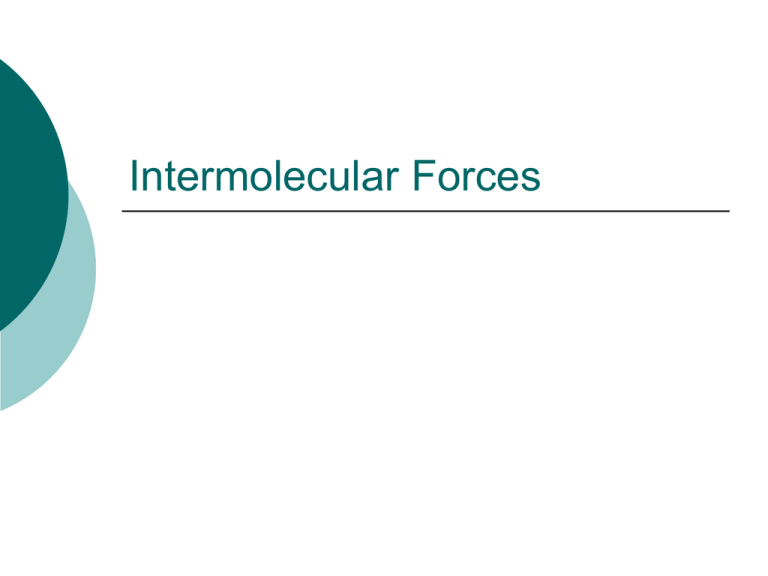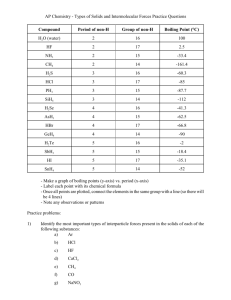Intermolecular Forces
advertisement

Intermolecular Forces Interesting Questions to answer The boiling point of the noble gas helium is -268.7oC, whereas the boiling point of the noble gas Neon is -245.9oC. What accounts for this difference? The boiling point of H2O is 100oC, whereas the boiling point of H2S is -59oC. What accounts for this difference? Carbon dioxide (CO2) is a gas at SATP, whereas Silicon dioxide (SiO2) is a solid. What accounts for this difference? What are Intermolecular Forces? Forces that bind atoms within a molecule are due to chemical bonding (i.e. sharing electrons) These forces are referred to as intramolecular forces Forces that hold molecules together are generally called intermolecular forces. What are Intermolecular Forces? Intermolecular forces are much weaker than the forces involved in chemical bonds However, intermolecular forces play a large role in the physical properties of substances, such as: State (solid, liquid, gas) Volatility (ability to vaporize) Melting/boiling point (self-explanatory) Types of Intermolecular Forces 1. We will discuss the following intermolecular forces: van der Waal’s forces 1. 2. 2. Dipole-dipole London forces (Dispersion) Hydrogen bonds van der Waal’s Forces Johannes van der Waals (1837 – 1923) was the first to suggest the importance of intermolecular forces. van der Waals forces is a general term for those intermolecular forces that include dipole-dipole and London forces. van der Waals forces is a very weak attractive force between many substances. Dipole-dipole Polar molecules can attract one another through dipole-dipole forces. A molecule is polar if it possesses an asymmetrical charge distribution. Molecules that possess this are said to have a dipole moment. Example of a dipole moment Dipole-dipole Dipole-dipole forces is an attractive intermolecular force resulting from the tendency of polar molecules to align themselves such that the positive end of one molecules is near the negative end of another. London Forces (Dispersion) Neon becomes a liquid at -2460C Since it forms a liquid, there must be forces adhering the molecules together Even substances that possess no dipole moments at all still possess intermolecular forces. This force is named after Fritz London London Forces (Dispersion) The electrons in an atom form a spherical distribution over time However, at any instant, more electrons may be present on one side of the nucleus than the other This creates a momentary dipole moment Formation of a dipole moment - - - - - + - - Neon atom without a dipole moment + - - - - - - - Neon atom with a dipole moment London Forces (Dispersion) If the neon atom with a dipole moment encounters another neon atom, it will induce a dipole moment in that neon atom This creates two dipoles that are momentarily attracted to each other. Creating a dispersion force London Forces (Dispersion) London forces (also called dispersion forces) are the weak attractive forces between molecules resulting from the small, instantaneous dipoles that occur because of the varying positions of the electrons during their motion about nuclei. London Forces (Dispersion) ALL substances possess dispersion forces The greater the number of electrons, the greater the dispersion force Examples of substances that ONLY possess dispersion forces: F2, Cl2, He, Ar, Kr, CH3, C2H6 Example Question Arrange the following substance in order of increasing magnitude of the London forces: SiCl4, CCl4, GeCl4. Answer – London forces increase with increasing number of electrons: CCl4 (74e-), SiCl4(82e-), GeCl4(100e-). Methanol vs. Fluoromethane Consider fluoromethane (CH3F)and methanol (CH3OH) Both have identical numbers of electrons (16 e-) and similar dipole moments However, CH3F boils at -78oC, and CH3OH boils at 65oC What accounts for this difference? Hydrogen Bonds Clearly methanol with its much higher boiling point has much stronger intermolecular forces than fluoromethane does. This introduces a new type of intermolecular force: Hydrogen bonding. Hydrogen Bonds Hydrogen bonding is a weak to moderate attractive force that exists between a hydrogen atom covalently bonded to a very electronegative atom, X, and a lone pair of electrons on another small, electronegative atom, Y. Hydrogen Bonds in Water Hydrogen Bonds Consider the boiling point of substances that contain hydrogen bonded to group VIA elements: Substance Boiling point H2O 100oC H2S -60oC H2Se -40oC H2Te 0oC Hydrogen Bonds Hydrogen bonding is present in water, but absent in H2S, H2Se, and H2Te. This is because the electronegativity difference between H and S, Se and Te is not great enough. Only molecules containing N-H, OH, and F-H bonds can form hydrogen bonds Hydrogen Bonds When water freezes, the molecules of water form hexagon-shaped crystals. This is due to the hydrogen bonds that form between water molecules. Hexagonal crystal lattice of H2O Example Question 1. 2. 3. What kinds of intermolecular forces are expected in the following substances? Methane Trichloromethane (chloroform) butanol Answers 1. 2. 3. Methane is nonpolar. Therefore only London (dispersion) forces are present. Chloroform is an unsymmetrical molecule with polar bonds. We would expect dipole-dipole forces and London forces Butanol has a hydrogen atom attached to an oxygen atom. Therefore, you expect hydrogen bonding. You would also expect dipole-dipole and London forces Homework Problems Page 266 #1-7






